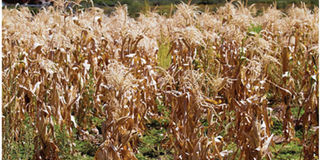Experts at war as maize growers harvest big losses

Maize crop ruined by an infection suspected to be Maize Lethal Necrosis Disease in Narok County. A report released this week by a government task force investigating the infection has warned that it is spreading. Photo/FILE
What you need to know:
- Kari scientists say disease that has wiped out crop in four provinces is viral, but experts at Kephis insist it’s fungal
The disease threatening to wipe out this year’s maize crop has spread to four provinces.
A task force established by the government to look into the crisis says the disease, which was first reported in Bomet last year, has spread to Rift Valley, Nyanza, Eastern and Central provinces.
It has destroyed crops on more than 90,000 hectares, according to the task force which presented its findings for the first time in public on Thursday.
“Where the crops were infected when young, losses are up to 100 per cent, ” Dr Anne Wangai, a member of the task force and a senior researcher with the Kenya Agricultural Institute (Kari), said.
The report reveals glaring conflicts between what the researchers have found out and what the Ministry of Agriculture has been telling the public.
Dr Wangai says the disease is caused by two different viruses working in cahoots.
She told the annual Open Forum on Agricultural Biotechnology in Africa in Nairobi that extensive trials both locally and abroad had confirmed that the infection was a viral disease.
But a statement issued by Agriculture minister Sally Kosgei in June, and posted on the ministry’s website, said the disease was also caused by a fungus.
“Confirmed results now indicate the combination of disease causing pathogens as mainly viruses and fungi... a fungus has been detected as one of the pathogens involved in the disease complex,” the statement said.
However, independent research by Kenya Plant Health Inspectorate (Kephis) was categorical that the disease was caused by a fungus.
Following Dr Kosgei’s statement, Kephis managing director James Onsando changed position but maintained that this was a new disease caused by a combination of viruses and fungi.
Kephis are part of the task force investigating the disease; so are several seed companies.
“The minister’s statement does not contradict our findings,” Dr Onsando told Saturday Nation without elaborating further.
However, scientists at International Maize and Wheat Improvement Centre (CIMMYT) are also categorical that the disease is caused by a virus.
“A combination of two viruses has been confirmed to be responsible for the Maize Lethal Necrosis Disease. This fact is now well established,” Dr Fred Kanampiu of CMMYT said.
Asked why Kephis could have got it so wrong, if indeed they are wrong, Dr Wangai argued that just like HIV, where an infected person is easy target for opportunistic infections, this may have been the case.
“A plant infected by these viruses has low immunity and will succumb to other infections, including fungal,” she said.
But scientists, who did not want to be identified for fear of victimisation, attributed the conflicting findings to sibling rivalry between Kari and Kephis, with the minister choosing to appease both.
“One is dead wrong and the government knows which one, but does not want to hurt anybody’s ego,” a source said.
But the confusion between facts, politics and commercial interests does not end there.
The government in its statement is also categorical that the disease is not transmitted through seeds.
“The disease affects all varieties of maize and we have confirmed that it is not seed borne,” Dr Kosgei said. “There is therefore no fear of spreading the disease through seed that is supplied by seed companies.”
But it has emerged that researchers have not established this as a fact. In fact they are screening seeds to determine whether they could be spreading the disease.
“We are conducting tests to verify seed transmission of viruses in local cultivars,” Dr Wangai said.
According to the task force report, a study done elsewhere in 1991 found seeds to be a possible transmission route.
Speaking on condition of anonymous, scientists attending the Thursday meeting and another one for science journalists in Nakuru a week ago, said seed companies afraid of compensating farmers and hurting their businesses are fighting against any attempt to link the disease with their products in spite of the facts.
While new in Kenya, Dr Wangai said the disease was first detected in Peru in 1973 and later in the US, Argentina and Mexico.
However, the report from Kephis suspects the disease to have originated from a maize seed production farm in Taveta, which had a similar problem in 2003.




